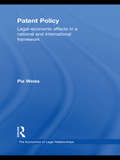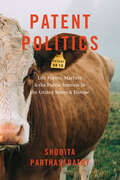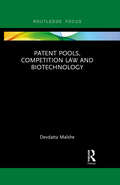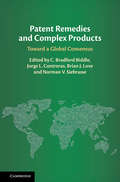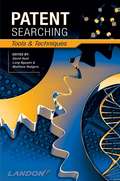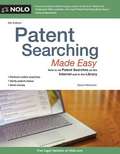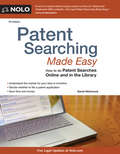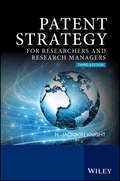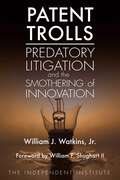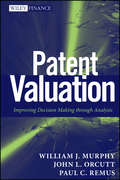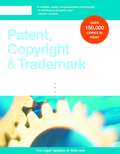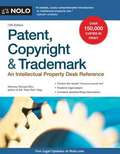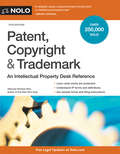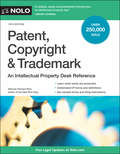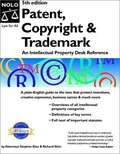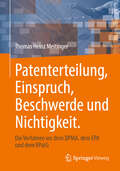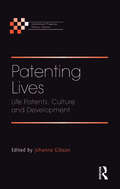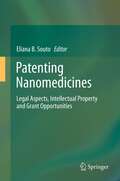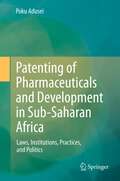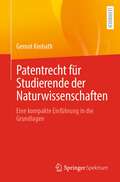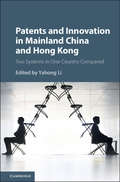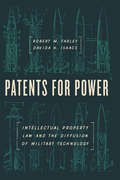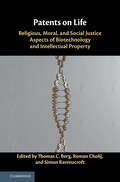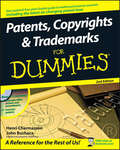- Table View
- List View
Patent Policy: Legal-Economic Effects in a National and International Framework (The\economics Of Legal Relationships Ser.)
by Pia WeissIntellectual property rights have become increasingly important for our modern economies in recent years. Although the entire patent system has a profound effect on the decision of firms of whether to conduct research and at which volume, patent law is the heart of the entire patent system. Therefore, this book focuses on the economic effects of certain provisions in patent law by using economic models dedicated to patent policy. The first part of the book presents a brief overview over the history of patent systems and introduces the main components of modern patent systems. A short introduction of the principal provisions of US patent law constitutes the centre of the subsequent analysis as it serves as a link between law and economics. The second part presents core economic models for central provisions, collecting the most fundamental results in a national framework in the field of literature. Part three is concerned with selected provisions of patent law in an international framework. It provides valuable insights into the situation of developing countries which are the chief recipients of technology transfers. Patent Policy will be of interest to researchers interested in the field of modelling patent policy. It can be also used as supplementary text in courses in Industrial Organization, Innovation Economics and Law and Economics.
Patent Politics: Life Forms, Markets, and the Public Interest in the United States and Europe
by Shobita ParthasarathyOver the past thirty years, the world’s patent systems have experienced pressure from civil society like never before. From farmers to patient advocates, new voices are arguing that patents impact public health, economic inequality, morality—and democracy. These challenges, to domains that we usually consider technical and legal, may seem surprising. But in Patent Politics, Shobita Parthasarathy argues that patent systems have always been deeply political and social. To demonstrate this, Parthasarathy takes readers through a particularly fierce and prolonged set of controversies over patents on life forms linked to important advances in biology and agriculture and potentially life-saving medicines. Comparing battles over patents on animals, human embryonic stem cells, human genes, and plants in the United States and Europe, she shows how political culture, ideology, and history shape patent system politics. Clashes over whose voices and which values matter in the patent system, as well as what counts as knowledge and whose expertise is important, look quite different in these two places. And through these debates, the United States and Europe are developing very different approaches to patent and innovation governance. Not just the first comprehensive look at the controversies swirling around biotechnology patents, Patent Politics is also the first in-depth analysis of the political underpinnings and implications of modern patent systems, and provides a timely analysis of how we can reform these systems around the world to maximize the public interest.
Patent Pools, Competition Law and Biotechnology (Routledge Research in Intellectual Property)
by Devdatta MalsheExploring the relationship between competition law and technology pools, this book provides general-purpose details of the biotechnology patent pool scheme while discussing historical developments, approaches of the US Department of Justice, Federal Trade Commission, and the European Union Competition Commission via EU regulations. In addition to these regulatory approaches and evolution in concept and theory of technology pools, this book illustrates relationship issues including tying arrangements and essential facility consideration vis-à-vis technology pools. It analyzes the modalities of forming such pools in the area of biotechnology, specifically illustrating that the formation of technology pools is possible and can be safely undertaken, and proposes a viable solution and structure. Patent pools in the biotechnology industry will pave the way towards open collaborative research, reducing patent thickets. Formation of such pools will increase access to various technology and patents otherwise out of bounds, resulting in a reduction of licensing costs and a spur in the development of new solutions. Most importantly, such pools will reduce the frequency of patent toll gates, making the entire spectrum of research interesting from the perspective of researchers as well as investors. This book will be an aid to researchers studying intellectual property, patents, and biotechnology, as well as to interest groups including funding agencies, venture funds, angel investors, and proponents of the open-source movement.
Patent Remedies and Complex Products: Toward a Global Consensus
by Jorge L. Contreras C. Bradford Biddle Brian J. Love Norman V. SiebrasseThrough a collaboration among twenty legal scholars from eleven countries in North America, Europe and Asia, Patent Remedies and Complex Products presents an international consensus on the use of patent remedies for complex products such as smartphones, computer networks and the Internet of Things. It covers the application of both monetary remedies like reasonable royalties, lost profits, and enhanced damages, as well as injunctive relief. Readers will also learn about the effect of competition laws and agreements to license standards-essential patents on terms that are 'fair, reasonable and non-discriminatory' (FRAND) on patent remedies. Where national values and policy make consensus difficult, contributors discuss the nature and direction of further research required to resolve disagreements. This title is also available as Open Access on Cambridge Core.
Patent Searching
by David Hunt Matthew Rodgers Long NguyenWhether you're a patent examiner, patent attorney, commercial patent searcher, patent liaison, IP librarian, law professor, or competitive intelligence analyst, you'll find Patent Searching: Tools and Techniques to be just the guide you have been waiting for, with a range of approaches to patent searching that will be useful to you regardless of your technical expertise or role in the intellectual property community.
Patent Searching Made Easy
by David HitchcockIn the past, if you wanted to assess the novelty of an idea, you had to wade through the patent database at the U.S. Patent and Trademark Office (PTO) in Virginia or hire a lawyer to do a patent search for $500 and up. The cost and inconvenience of these searches often meant that good ideas were left to rot on the vine. Patent Searching Made Easy shows you how do patent searches yourself, on the Internet, at little or no cost. Plus, you'll learn how to: . verify the patent status of an idea . prepare for online searches with the right hardware, software and computer skills . access online patent searching resources . narrow online searches with keywords and Boolean logic . perform database searches at Patent and Trademark Resource Centers (PTRC) . do prior art searches at PTRC . search fee based patent databases on the Internet . search international patent offices . do advanced searches at the PTO and PTRC Written for both inventors and business owners interested in expanding their product line through the license, distribution or manufacture of other people's ideas, Patent Searching Made Easy is the easiest way for you to determine the answer to that all important question, "Am I the first?" A physicist, engineer, and patent searching expert, author David Hitchcock gives you the vocabulary, instructions and strategies you need to search for a patent quickly and easily. He explains how the PTO classifies different types of inventions, so that you can assign your idea to the right class, compare it to related ideas and then determine if it's novel enough to qualify for a patent.
Patent Searching Made Easy: How to do Patent Searches Online and in the Library
by David HitchcockInventor? Find out if you're the first to file a patent, online and in the library In the past, if you wanted to assess the novelty of an idea, you had to wade through the patent database at the U.S. Patent and Trademark Office (PTO) in Virginia -- or hire a lawyer to do a patent search for $500 and up. The cost and inconvenience of these searches often meant that good ideas were left to rot on the vine. In Patent Searching Made Easy, find the plain-English information you need to: verify the patent status of an idea search Patent and Trademark Depository Libraries use online patent search services A physicist, engineer, and patent searching expert, author David Hitchcock gives you the vocabulary, instructions and strategies you need to search for a patent quickly and easily. He explains how the PTO classifies different types of inventions, so that you can assign your idea to the right class, compare it to related ideas, and then determine if it's novel enough to qualify for a patent. Patent Searching Made Easy shows you how do patent searches yourself, on the Internet, at little or no cost. Plus, you'll learn how to: prepare for online searches with the right hardware, software and computer skills access online patent searching resources narrow online searches with keywords and Boolean logic perform database searches at Patent and Trademark Depository Libraries (PTDLs) do microfiche searches at PTDLs search fee-based patent databases on the Internet search international patent offices, and do advanced searches at the PTO and PTDL. Written for both inventors and business owners interested in expanding their product line through the license, distribution or manufacture of other people's ideas, Patent Searching Made Easy is the easiest way for you to determine the answer to that all-important question, "Am I the first?"
Patent Strategy for Researchers and Research Managers
by H. Jackson KnightAs individuals and companies realise the importance of their inventions, issues surrounding patent laws and practices are taking centre stage around the world.Patent Strategy introduces researchers to patent applications and patent portfolios. With minimum use of 'legal jargon' it provides the technical professional with the assistance and advice they require to understand the legal complexities that they may encounter before and during a patent application. It also discusses the responsibilities of the researcher after patent applications have been filed and the role the researcher can play in the maintenance of a global patent estate.This updated edition of the best selling book has been expanded to keep pace with modern day movements and addresses the global issue surrounding intellectual property. Including new information on areas such as software and biotechnology it shows the techniques that can be used by individuals and academic inventors to protect their work and is the ideal reference source.Bridges the gap between the legal system and scientific research and avoids legal jargonDetails the reasons behind patents, their importance and relevance to all researchers and the strategy needed for filing for a patentFocuses on the strategy and reasons rather than just being a textbook of patent lawPresents an overview of tools a researcher can use while working with a patent attorney or agentAdopts a readable style that explains the basics right up to developing a strategyEssential reading for all those who wish to keep pace and protect their workReviews from previous edition:"...I can recommend it for technology managing types. Does a nice job of explaining many aspects of the patent system and patent strategies with a minimum of jargon and case citations..."--Internet Patent News"...provides an enlightened approach to a complex subject. It is relatively easy to read and follow..."-- Polymers Paint and Colour Journal"This handy book provides the researcher with useful guidance on how to maximize the benefit of their inventiveness to themselves and their organization".--Journal of Chemical Technology and Biotechnology
Patent Trolls: Predatory Litigation and the Smothering of Innovation
by William J. Watkins Jr.Patent trolls are stifling innovation.Using overbroad patents based on dated technology, trolls threaten litigation and bring infringement suits against inventors. Trolls, also known as Non-Practicing Entities (&“NPEs&”), typically do not produce products or services, but are in the business of litigation. They lie in wait for someone to create a process or product that has some relationship to the patent held by the troll, and then they pounce with threats and lawsuits. The cost to the economy is staggering. Watkins calls attention to this problem and the challenges it poses to maintaining a robust rate of technologically progress. He also examines a more fundamental problem: an outmoded patent system that is fundamentally ill suited for the modern economy. Finally, he examines proposals for reforming the patent system.
Patent Valuation
by William J. Murphy John L. Orcutt Paul C. RemusA practical resource for valuing patents that is accessible to the complete spectrum of decision makers in the patent processIn today's economy, patents tend to be the most important of the intellectual property (IP) assets. It is often the ability to create, manage, defend, and extract value from patents that can distinguish competitive success and significant wealth creation from competitive failure and economic waste. Patent Valuation enhances the utility and value of patents by providing IP managers, IP creators, attorneys, and government officials with a useable resource that allows them to use actual or implied valuations when making patent-related decisions.Involves a combination of techniques for describing patent valuationIncludes descriptions of various topics, illustrative cases, step-by-step valuation techniques, user-friendly procedures and checklists, and examplesServes as a useable resource that allows IP managers to use actual or implied valuations when making patent-related decisionsOne of the most fundamental premises of the book is that these valuation skills can be made accessible to each of the various decision makers in the patent process. Patent Valuation involves narrative descriptions of the various topics, illustrative cases, step-by-step valuation techniques, user-friendly procedures and checklists, and an abundance of examples to demonstrate the more complex concepts.
Patent, Copyright & Trademark
by Richard StimWhether you're an inventor, designer, writer or programmer, you need to understand the language of intellectual property law. Otherwise, you can't intelligently deal with intellectual property issues such as: . who owns creative works or valuable information . how owners can protect and enforce their ownership rights . how disputes between intellectual property owners can be resolved, and . how ownership rights can best be transferred to others. With Patent, Copyright & Trademark, you will: . get clear overviews of relevant laws . understand the different kinds of protection offered by patents, copyrights, trademarks and trade secrets -- and which apply to your work . get a plain-English definition of every term you're likely to come across, and . find the information you need, quickly and easily -- all entries are organized by topic and extensively cross-referenced. This edition has been updated to reflect the latest changes in intellectual property law and provides the latest U.S. Patent and Trademark Office rules and forms. It includes up-to-date discussions of the new "first to file" rule, which promises to revolutionize patent law. Plus, read all new Q&As excerpted from author Richard Stim's popular blog, Dear Rich.
Patent, Copyright & Trademark
by Richard Stim AttorneyWhether you're investigating patent, copyright or trademark law, get the most concise and comprehensive explanations of intellectual property in one volume! Whether you're an Edison, Faulkner or Jobs, you need Patent, Copyright & Trademark. Intellectual property law has rapidly produced its own language. But don't count on understanding it right off the bat -- the terms baffle lawyers and lay folk alike. Whether you're an inventor, designer, writer or programmer, you need to understand the language of intellectual property law to intelligently deal with such issues as: who owns creative works or valuable information how these owners can protect and enforce their ownership rights how disputes between intellectual property owners can be resolved, and how ownership rights can best be transferred to others. With this essential guide, you will: get clear overviews of relevant laws understand the different kinds of protection offered by patents, copyrights, trademarks and trade secrets -- and which apply to your work get a plain-English definition of every term you're likely to come across, and find the information you need, quickly and easily -- all entries are organized by topic and extensively cross-referenced. The 12th edition has been thoroughly revised and updated with the most up-to-date case law and legislation on patents, copyrights, trademark and all other issues intellectual property. Plus, read all new Q&As excerpted from author Richard Stim's regularly updated blog, Dear Rich.
Patent, Copyright & Trademark: An Intellectual Property Desk Reference
by Richard StimA plain-English guide to intellectual property law Whether you are in the world of business or creative arts, you need to understand the laws that govern your work. But given the convoluted terminology that surrounds patents, copyrights, trademarks, and other intellectual property rights, this isn't easy. Enter, Patent, Copyright & Trademark, which explains: what legal rights apply to your work the scope of copyright protection an overview of trademark law, and what trade secret law protects. Here, you'll find plain-English definitions of intellectual property law terms, straightforward explanations of how intellectual property law affects online content, and much more. This edition is completely updated to provide the latest laws, court decisions, and sample forms.
Patent, Copyright & Trademark: An Intellectual Property Desk Reference
by Richard StimA plain-English guide to intellectual property law Whether you are in the world of business or creative arts, understanding the laws that govern your work is critical to success. But given the convoluted terminology that surrounds patents, copyrights, trademarks, and other intellectual property rights, this isn’t easy. Enter Patent, Copyright & Trademark, which explains: what legal rights apply to your creations, products, or inventions different types of patents for inventions from machines to plant clones the scope of copyright protection how trademark law works, and what trade-secret law protects. Here, you’ll find readily understandable definitions of intellectual property law terms, straightforward explanations of how intellectual property law affects online content, and much more. The 16th edition is completely updated to provide the latest laws, court decisions, and sample application and other forms.
Patent, Copyright and Trademark (5th edition)
by Richard Stim Stephen EliasThis work offers information in plain language on basics of intellectual property law and related legal terms. It explains how to protect intellectual property and how intellectual property law affects the Internet.
Patenterteilung, Einspruch, Beschwerde und Nichtigkeit.: Die Verfahren vor dem DPMA, dem EPA und dem BPatG
by Thomas Heinz MeitingerDieses Buch beschreibt das amtliche Patenterteilungsverfahren vor dem Deutschen Patent- und Markenamt und dem Europäischen Patentamt und gibt praktische Anleitungen, um eine zügige Patenterteilung zu erreichen. Gelingt die Patenterteilung nicht, kann der Zurückweisungsbeschluss des Patentamts durch eine sogenannte „Anmelderbeschwerde&“ angefochten werden. Ein bestehendes fremdes Patent kann innerhalb der Einspruchsfrist durch ein Einspruchsverfahren angegriffen werden. Nach Ablauf der Einspruchsfrist besteht die Möglichkeit der Nichtigerklärung des fremden Patents vor dem Bundespatentgericht. Vor dem Bundesgerichtshof in Karlsruhe finden die Nichtigkeitsberufungsverfahren statt. Außerdem gibt es noch amtliche Löschungsverfahren gegen Gebrauchsmuster, Marken und Designrechte. Alle diese Verfahren vor dem DPMA (Deutsches Patent- und Markenamt), dem EPA (Europäisches Patentamt), dem BPatG (Bundespatentgericht), dem BGH (Bundesgerichtshof), dem EUIPO (European Union Intellectual Property Office) und dem EPG (Einheitliches Patentgericht) werden in diesem Buch beschrieben.
Patenting Lives: Life Patents, Culture and Development (Intellectual Property, Theory, Culture)
by Johanna GibsonPatenting Lives includes contributions from various interests and perspectives, both in the context of current international developments in life patents and the global agenda of harmonization of international intellectual property. The book is divided into five sections reflecting the critical issues arising from patents and biotechnology - Context; Human Rights and Ethical Frameworks; Medicine and Public Health; Traditional Knowledge; and Agriculture. The international contributors from government, civil society, academia and the private sector provide diverse perspectives on life patents and the facilitation of social, cultural and economic development in the context of international principles of trade.
Patenting Nanomedicines
by Eliana B. Souto"Patenting Nanomedicines: Legal Aspects, Intellectual Property and Grant Opportunities" focusses on the fundamental aspects of Patenting Nanomedicines applied in different "Drug Delivery and Targeting Systems". The promoters of new findings in this field of research are numerous and spread worldwide; therefore, managing intellectual property portfolios, and the acquisition and exploitation of new knowledge face several contingency factors. Today, the scientific community is discussing issues of economic outcomes in the field of Nanomedicines. Major concerns include questions as to whether the research groups, academics, industry and other stakeholders should work in unison or independently, if innovation or adaptation of new technology should be prioritized, public versus private research funding, and safeguarding versus sharing knowledge. However, despite its increasing importance for humankind, it is a matter of concern as to whether technological development can really be stimulated by patent protection. An intellectual property strategy should aim to develop a qualitative patent portfolio for continuous learning. This book addresses questions of ethics, socio-political policies and regulatory aspects of novel Nanomedicine-based products which are currently under development for the diagnosis and treatment of different types of diseases. It is divided in two parts - Part I is composed of the first 3 chapters, which focus on the "fundamentals" of legal aspects, emerging threats, advantages and disadvantages of patenting Nanomedicines, whereas Part II collects 12 chapters discussing different types of Nanomedicine-based products, their potential marketing aspects and patent protection. Whenever applied, each chapter offers a list of patents, based on a specific application in drug delivery and targeting. An outstanding team of 53 authors have contributed to this book, which will be of interest to professionals from the field of patent examiners, academics, researchers and scientists, students and other practitioners.
Patenting of Pharmaceuticals and Development in Sub-Saharan Africa
by Poku AduseiThis book critically investigates the patent protection of medication in light of the threats posed by HIV/AIDS, malaria and tuberculosis epidemics to the citizens of countries in Sub-Saharan Africa (hereinafter "SSA" or "Africa"). The book outlines the systemic problems associated with the prevailing globalized patent regime and the regime's inability to promote access to life-saving medication at affordable prices in SSA. It argues that for pharmaceutical patents to retain their relevance in SSA countries, human development concepts must be integrated into global patent law- and policy-making. An integrative approach implies developing additional public health and human development exceptions/limitations to the exercise of patent rights with the goal of scaling up access to medication that can treat epidemics in SSA. By drawing on multiple perspectives of laws, institutions, practices, and politics, the book suggests that SSA countries adopt an evidence-based approach to implementing global patent standards in domestic jurisdictions. This evidence-based approach would include mechanisms like local need assessments and the use of empirical data to shape domestic patent law-making endeavors. The approach also implies revising patent rules and policies with a pro-poor and pro-health emphasis, so that medication will be more affordable and accessible to the citizens of SSA countries. It also suggests considering the opinions of individuals and pro-access institutions in enacting crucial pieces of health-related statutes in SSA countries. The approach in this book is sensitive to the public health needs of the citizens affected by epidemics and to the imperative of building local manufacturing facilities for pharmaceutical research and development in SSA.
Patentrecht für Studierende der Naturwissenschaften: Eine kompakte Einführung in die Grundlagen
by Gernot KrobathDieses Lehrbuch bietet einen kompakten Einstieg in das Patentrecht für Studierende der Naturwissenschaften. Es präsentiert das wesentliche Grundwissen zum deutschen und europäischen Patentrecht. Dabei vertieft sich das Buch bewusst nicht in selten auftretende Spezialfälle oder juristische Feinheiten, sondern es ermöglicht den Lesern, ein Grundverständnis für die zentralen Begriffe und Grundprinzipien des Patentrechts zu entwickeln. Das Lehrbuch enthält zahlreiche Kurzbeispiele und Fallfragen mit Lösungen, anhand derer der Leser die Inhalte verstehen und nachvollziehen kann.
Patents and Global Administrative Law: Values, Principles, and Challenges
by David TiltThe book applies values and concepts from Global Administrative Law (GAL) to international patent law, demonstrating how limiting technocratic and overly economic language can be. Highlighting the administrative foundations of patent law, the book argues that, in its international form, it can be analysed using the same principles of participation, transparency, and accountability found in national administrative law.At the heart of the book is a simple question: What does international patent law look like when we approach it through the lens of these values? What is being left out when patent law is described predominantly in terms of its technical legal provisions or economic impact? The book presents three interrelated contexts: EU patent law, bilateral trade agreements, and the multilateral space. Modern patent law is increasingly discussed in terms of national competitiveness or economic potential, which reveals only a narrow understanding of how patent law evolves and functions. The vocabulary of administrative law provides a fresh way of recasting, reframing, and re-describing the dynamics of international patent law in a way that is more accessible to those outside of a traditional patent scholarship audience. A fundamental objective of the book is to challenge the tendency towards technocratic isolation in patent law. The book uses accessible vocabulary and represents a new way of conceptualising and understanding how patent law develops on a global scale.The book will be of interest to researchers in the field of patent law, international law, and administrative law.
Patents and Innovation in China and Hong Kong: Two Systems in One Country Compared
by Yahong LiHow do patents affect innovation in Mainland China and Hong Kong? How can two patent systems operate within one country and how is innovation affected by the 'one country two systems' model? For the first time, this book links these challenging issues together and provides a comprehensive overview for government officials, law-makers, academics, law practitioners and students to understand the patent systems of Mainland China and Hong Kong. Themes examined include the interaction between the two distinctive patent regimes, the impact of patents on innovation in China's specific industries such as green tech, traditional Chinese medicines and telecommunications, the role of utility models in inflating low-quality patents and the application of good faith principle in enforcing FRAND in Mainland China, patent system reforms in Hong Kong, and the impact of these changes on innovation in the two vastly distinctive yet closely connected jurisdictions.
Patents for Power: Intellectual Property Law and the Diffusion of Military Technology
by Robert M. Farley Davida H. IsaacsIn an era when knowledge can travel with astonishing speed, the need for analysis of intellectual property (IP) law—and its focus on patents, trade secrets, trademarks, and issues of copyright—has never been greater. But as Robert M. Farley and Davida H. Isaacs stress in Patents for Power, we have long overlooked critical ties between IP law and one area of worldwide concern: military technology. This deft blend of case studies, theoretical analyses, and policy advice reveals the fundamental role of IP law in shaping how states create and transmit defense equipment and weaponry. The book probes two major issues: the effect of IP law on innovation itself and the effect of IP law on the international diffusion, or sharing, of technology. Discussing a range of inventions, from the AK-47 rifle to the B-29 Superfortress bomber to the MQ-1 Predator drone, the authors show how IP systems (or their lack) have impacted domestic and international relations across a number of countries, including the United States, Russia, China, and South Korea. The study finds, among other results, that while the open nature of the IP system may encourage industrial espionage like cyberwarfare, increased state uptake of IP law is helping to establish international standards for IP protection. This clear-eyed approach to law and national security is thus essential for anyone interested in history, political science, and legal studies.
Patents on Life: Religious, Moral, and Social Justice Aspects of Biotechnology and Intellectual Property
by Simon Ravenscroft Thomas C. Berg Roman CholijThis volume brings together a unique collection of legal, religious, ethical, and political perspectives to bear on debates concerning biotechnology patents, or 'patents on life'. The ever-increasing importance of biotechnologies has generated continual questions about how intellectual property law should treat such technologies, especially those raising ethical or social-justice concerns. Even after many years and court decisions, important contested issues remain concerning ownership of and rewards from biotechnology - from human genetic material to genetically engineered plants – and regarding the scope of moral or social-justice limitations on patents or licensing practices. This book explores a range of related issues, including questions concerning morality and patentability, biotechnology and human dignity, and what constitute fair rewards from genetic resources. It features high-level international, interfaith, and cross-disciplinary contributions from experts in law, religion, and ethics, including academics and practitioners, placing religious and secular perspectives into dialogue to examine the full implications of patenting life.
Patents, Copyrights & Trademarks For Dummies
by John Buchaca Henri J. CharmassonUseful tips and step-by-step guidance from filing to issue to licenseAcquire and protect your share of this major business assetWant to secure and exploit the intellectual property rights due you or your company? This easy-to-follow guide shows you how -- helping you to evaluate your idea's commercial potential, conduct patent and trademark searches, document the invention process, license your IP rights, and comply with international laws. Plus, you get detailed examples of each patent application type!Discover how to:Avoid application blundersRegister trademarks and copyrightsMeet patent requirementsNavigate complex legal issuesProtect your rights abroadThe entire body of U.S. patent lawsExample office actions and amendmentsSample formsTrademark registration certificatesApplication worksheetsSee the CD appendix for details and complete system requirements.Note: CD-ROM/DVD and other supplementary materials are not included as part of eBook file.
